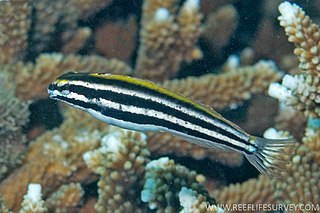
Blenniella bilitonensis, also known as Biliton blenniella or the lined rockskipper, is a species of combtooth blenny found in the western Pacific ocean.

Blenniella gibbifrons, also known as the hump-headed blenny, bullethead rockskipper or picture rockskipper, is a species of combtooth blenny found in coral reefs in the Pacific and Indian Oceans from East Africa in the west to the Hawaiian, Line and Ducie Islands, in the east and north to Marcus Island.

Blenniella paula, the blue-dashed rockskipper, is a species of combtooth blenny found in coral reefs in the western Pacific ocean.

Blenniella periophthalmus is a species of combtooth blenny found in coral reefs in the Pacific and Indian oceans. It is commonly known as the blue-dashed rockskipper, bullethead rockskipper, false rockskipper, or the peppered blenny. B. periophthalmus are oviparous animals and once they lay eggs, the eggs attach to the surface of the sea floor due to an adhesive coating. B. periophthalmus prefer a depth range of 0-3 meters and can have a maximum body length of 10 centimeters.

Istiblennius is a genus of combtooth blennies found in the Pacific and Indian Oceans. The generic name is a compound noun composed of istio the Greek for "sail", referring to the high dorsal fin of the type species, Istiblennius muelleri, and blennius which is derived from a word for "mucus" and refers to the scaleless bodies that characterise the Blenniidae.

Istiblennius bellus, the imspringer, is a species of combtooth blenny found in coral reefs in the Pacific and western Indian Ocean. It is also known as the beautiful rockskipper or the dusky blenny. Males of this species can reach a maximum of 16 cm (6.3 in) SL, while females reach a maximum of 13.1 cm (5.2 in) SL.

Istiblennius edentulus, the rippled rockskipper, is a species of combtooth blenny found in coral reefs in the Pacific and Indian Oceans. It is also commonly known as the rippled blenny, smooth-lipped blenny, toothless blenny, or coral blenny. Males of this species can reach a maximum of 16 cm (6.3 in) TL, while females can reach a maximum of 13.2 cm (5.2 in) SL.
Istiblennius flaviumbrinus is a species of combtooth blenny found in the western Indian Ocean, specifically the Red Sea. Males of this species can reach a maximum of 9 cm (3.5 in) SL, while females can reach a maximum of 7.2 cm (2.8 in) SL.

Istiblennius meleagris, the peacock rockskipper, is a species of combtooth blenny found in coral reefs in the western Pacific ocean. It is also known as the white-speckled blenny. Males can reach a maximum of 15 cm (5.9 in) TL, while females can reach a maximum of 10.6 cm (4.2 in) SL.
Istiblennius muelleri, Mueller's rockskipper, is a species of combtooth blenny found in the western Pacific ocean. Males of this species can reach a maximum of 7 cm (2.8 in) SL, while females can reach a maximum of 5.5 cm (2.2 in) SL. The specific zoology honours the German-Australian physician, geographer, and botanist Ferdinand von Mueller (1825-1896).
Istiblennius pox, the scarface rockskipper, is a species of combtooth blenny found in the western Indian Ocean. It can reach a maximum of 13 cm (5.1 in) TL.
Istiblennius rivulatus is a species of combtooth blenny found on coral reefs in the western Indian Ocean. Males of this species can reach a maximum of 8.6 cm (3.4 in) in standard length, while females can reach a maximum of 9.3 cm (3.7 in) in standard length.

Istiblennius spilotus, the spotted rockskipper, is a species of combtooth blenny found in the western Indian Ocean. Males of this species can reach a maximum of 14 cm (5.5 in) TL, while females can reach a maximum length of 9.7 cm (3.8 in) SL.
Istiblennius steindachneri is a species of combtooth blenny found in the western Indian Ocean. It can reach a maximum of 11 cm (4.3 in) in SL. The identity of the person honoured in this blenny's specific name was not stated by Pfeffer in his description but it is almost certainly the Austrian ichthyologist Franz Steindachner (1834-1919).

Istiblennius unicolor, the pallid rockskipper, is a species of combtooth blenny found on coral reefs in the western Indian Ocean. Males of this species can reach a maximum standard length of 10.2 cm (4.0 in), while females can reach a maximum length of 9.2 cm (3.6 in).

Istiblennius zebra, Pāoʻo, the zebra blenny, is a species of combtooth blenny found in tide pools around the Hawaiian Islands. It is also commonly known as the zebra rockskipper, rockskipper, jumping jack or the gori.

Meiacanthus lineatus, the lined fangblenny, is a venomous species of combtooth blenny found in the Great Barrier Reef in the western Pacific Ocean. This species grows to a length of 9.5 centimetres (3.7 in) TL.
Paralticus amboinensis, the Ambon rockskipper or the big-nose blenny, is a species of combtooth blenny found in the western central Pacific Ocean. This species reaches a length of 16 centimetres (6.3 in) TL. It is currently the only known member of its genus.
Praealticus multistriatus, the linedfin rockskipper , is a species of combtooth blenny found in the Pacific Ocean, around Tonga.
Praealticus natalis, the Christmas rockskipper, Natal blenny or the Natal rockskipper, is a species of combtooth blenny found in coral reefs around Christmas Island in the eastern Indian Ocean. This species grows to a length of 8 centimetres (3.1 in) TL.













